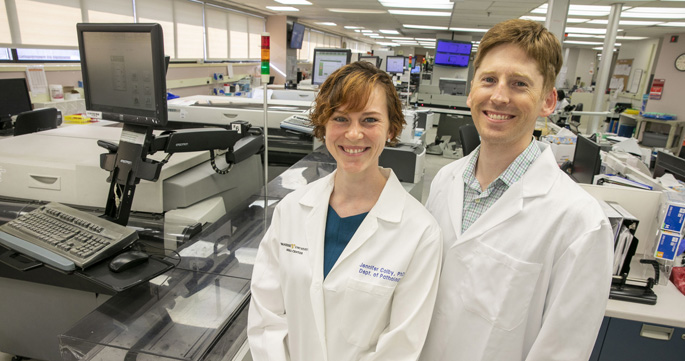
by Paul Govern
False positives on urine drug screens are common and are frequently due to cross-reactivity of these tests to medications. Last year, Vanderbilt University Medical Center researchers Jacob Hughey, PhD, assistant professor of Biomedical Informatics, and Jennifer Colby, PhD, at that time assistant professor of Pathology, Microbiology and Immunology, devised, tested and published a method to systematically identify medications that interfere with screenings for drugs of abuse.
With a new paper in the Journal of Analytical Toxicology, Colby and Hughey are back with a more general method that could help identify even more interfering medications.
At VUMC, outside the Emergency Department, most positive urine drug screens are automatically followed up by confirmatory testing to reveal any false positives. In the 2019 paper, the team based their analysis on de-identified electronic health records (EHRs) from some 40,000 patients who had undergone urine drug screening, using the recent medication histories of this group to identify medications associated with positive drug screens that turned out to be false.
They spiked drug-free urine with these medications, revealing 13 interfering drug compounds that were previously unknown to cause false-positive screenings for amphetamines, buprenorphine (an opioid), cannabinoids and methadone.
That method required confirmatory tests, but “many hospitals don’t do these confirmatory tests for positive drug screens,” Colby said. So, for the new paper, they looked strictly for associations between medications and positive drug screens, in the absence of confirmatory testing.
They began by running both methods on their previous 40,000-patient data set, and found that, compared to the method that used false positives, the new method based strictly on presumptive positives picked up “only moderately fewer” of the known interfering medications.
Next, they gathered de-identified EHRs of another 40,000 patients who had been tested for certain drug ingredients for which VUMC does not typically run confirmatory tests, one of these being acetaminophen.
The new method pointed to three medications as potential sources of positive acetaminophen screens: levodopa, carbidopa and entacapone.
Using a urine-spiking experiment similar to their earlier study, the team found that all three interfered with this drug screen.
“The new method has the advantage of potentially applying to any institution’s EHR, even if confirmation results are not available,” Hughey said.
The team suggests that their method could serve as a basis for post-marketing surveillance of urine drug screening assays, writing that, “given the limited number of assay manufacturers, implementation of surveillance programs at several large sites could be sufficient to uncover the majority of interfering medications. This information could then be disseminated to benefit the entire laboratory community.”
Colby and Hughey were joined in the study by Nadia Ayala-Lopez and Layla Aref. The study was supported in part by the National Institutes of Health (TR002243).












